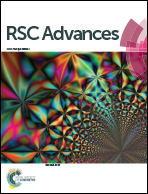Antifouling hydrogel film based on a sandwich array for salivary glucose monitoring†
Abstract
A glucose biosensor prepared using interpenetrating polymer network (IPN) hydrogel as a sensing material is the subject of growing interest due to its fast response and high sensitivity. However, the IPN hydrogel circumvents the traditional antifouling strategy, which often requires thick antifouling coating that can result in poor glucose sensitivity owing to its energetic physical barrier (greater than 43 nm); thus a complex, time-consuming and high-cost salivary preprocessing is needed to remove protein contaminants before salivary glucose detection using the IPN hydrogel. This limits its practical application in trace salivary glucose-level monitoring. Herein, a new hydrogel film based on a sandwich array (HFSA) with a weak physical barrier, which exhibits superior antifouling and sensitivity in salivary glucose detection is reported. HFSA relies on the formation of the sandwich structure containing substrate-grafted, surface-grafted zwitterionic polymer brushes (pSBMA) and phenylboronic acid (PBA)-functionalized hydrogel. The synergistic effect originating from pSBMA brushes on the surface of HFSA and inside the HFSA matrix provides a suitable physical barrier (∼28 nm) and a robust hydration layer for HFSA, which can enhance its sensitivity and antifouling. The results show that HFSA reduce the adsorption of nonspecific protein in 10% saliva by nearly 90% and enhanced the glucose sensitivity by 130%, compared to the IPN hydrogel film. These results demonstrate that HFSA exhibits significant potential as an antifouling and sensitive glucose probe for QCM sensors in non-invasive salivary glucose monitoring.



 Please wait while we load your content...
Please wait while we load your content...